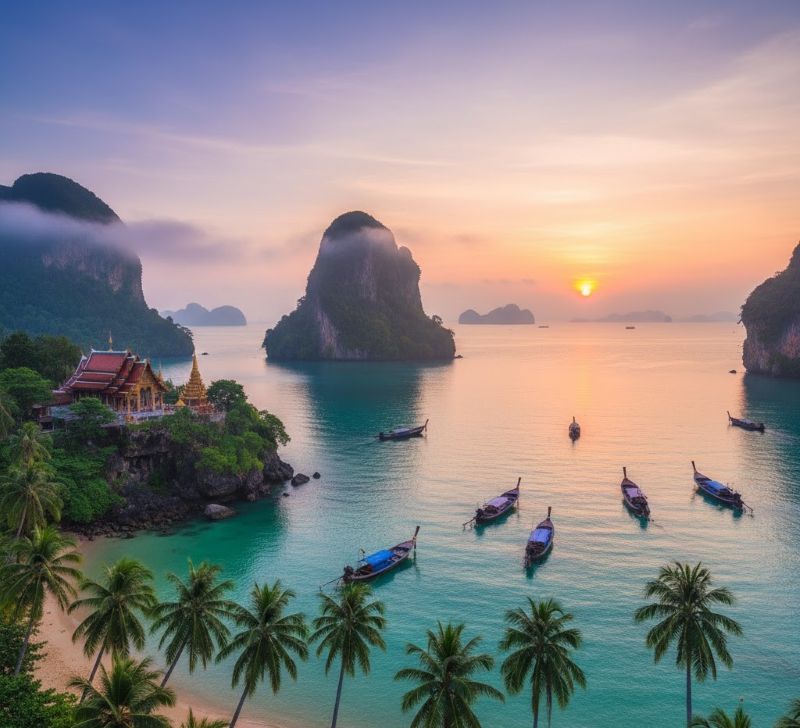Jimbaran Bay Joins Canggu, Sanur Beach, Ubud, and Beyond, The Booming Travel Buzz Turning Bali, Indonesia into Every Traveler’s Dream, Will You Join In

When much of the world lies beneath winter’s frosty hush, Bali awakens under skies of liquid gold. The island becomes a sanctuary for travelers searching for warmth, peace, and renewal. During Winter 2025, when temperatures hover gently between 26°C and 30°C, Bali transforms into a haven of sunlight — a place where time slows, and the spirit stirs. The moment one steps onto its shores, the air itself feels alive, carrying whispers of incense, ocean salt, and ancient devotion.
The island’s rhythm is shaped by its contrasts — from the tranquil Sanur Beach, where sunrise paints the sea in coral tones, to the lively Seminyak Beach, where evenings glow with music and laughter. Between them lie worlds apart yet harmoniously connected: Ubud, the cultural heart surrounded by emerald terraces and sacred rivers, and Canggu, the bohemian stretch where surfers and dreamers blend creativity with calm.
For the seeker of serenity, Nusa Dua offers luxury wrapped in silence, while Jimbaran Bay reveals romance under starlit skies, where dining becomes poetry beside the waves. In contrast, the dramatic cliffs of Uluwatu Temple awaken awe with their sheer majesty, and the sea-washed rock of Tanah Lot captures faith in motion, standing proud against tides and time.
Deeper inland, the Besakih Temple, resting on the mighty slopes of Mount Agung, carries the heartbeat of Bali’s spirituality — a living testament to centuries of devotion. Not far away, the elegant Pura Taman Ayun mirrors heaven and earth through stone and water, embodying the island’s belief in balance and harmony. Every temple, every forest, every beach whispers a truth: that Bali is not merely a destination but a living spirit — one that welcomes, heals, and transforms.
This winter, as travelers seek warmth in a world wrapped in snow, Bali stands ready with open arms. Its beauty lies not only in its landscapes but in its soul — in every offering placed at a doorstep, every smile exchanged at dawn, every wave that kisses the shore. From Ubud to Tanah Lot, from Sanur to Uluwatu, each corner tells a story — one of light, devotion, and timeless wonder.
Seminyak Beach – The Chic Heart of Bali
Among Bali’s most stylish shores, Seminyak Beach embodies sophistication wrapped in tropical ease. Its golden sands stretch under the vast horizon, where gentle waves meet boutique resorts and tranquil cafes. During the day, travelers soak up sunshine, while evenings come alive with glowing sunsets and rhythmic laughter echoing along the coastline.
This vibrant area symbolizes modern Balinese luxury — refined yet grounded in local artistry. Visitors wander through art markets, discovering intricate handicrafts and vibrant textiles that reflect Bali’s creative pulse. The beach is also a hub for those seeking holistic wellness; spa rituals, yoga sessions, and sunset meditations fill the air with calm.
What sets Seminyak apart is its balance of indulgence and mindfulness. It doesn’t shout opulence; it sings it softly through elegance, hospitality, and harmony. Every sunrise here is an invitation to pause, breathe, and simply be.
Uluwatu Temple – The Guardian Above the Sea
Perched dramatically atop a 70-meter cliff, the Uluwatu Temple commands one of Bali’s most unforgettable views of the Indian Ocean. This sacred sanctuary, dating back to the 11th century, watches over the island’s southern seas — a symbol of spiritual protection and natural majesty.
As the sun begins its descent, travelers gather along the cliff’s edge to witness the Kecak fire dance, a hypnotic performance blending devotion, mythology, and art. Flames rise against the twilight sky, and the ocean roars below — an unforgettable meeting of earth, fire, and water.
Beyond its cultural essence, Uluwatu’s cliffs remind every visitor of nature’s grandeur and human humility. For the travel industry, this place reflects Bali’s growing reputation as a destination where culture and nature coexist in perfect rhythm, inviting the world to seek depth, not just beauty.
Nusa Dua – Serenity Wrapped in Luxury
In southern Bali, Nusa Dua presents a world of elegance and calm. With crystal-clear waters, white sands, and lush gardens, this coastal paradise redefines relaxation. It’s where luxury whispers rather than shouts — every detail crafted for peace and refinement.
Families find safety and comfort here, strolling through shaded promenades or enjoying gentle water sports. Couples retreat into private sanctuaries where the only sounds are waves and wind. Even within its modern appeal, Nusa Dua preserves traditional culture through Balinese performances, handcrafted art, and local rituals that weave heritage into modern hospitality.
For global travelers, Nusa Dua symbolizes responsible tourism, where sophistication blends seamlessly with sustainability. It teaches destinations worldwide that progress need not erase culture — it can protect and celebrate it.
Tanah Lot – The Ocean’s Divine Embrace
Few images of Bali are as striking as Tanah Lot, rising majestically from a sea-bathed rock formation. Built in the 16th century, this temple honors the sea deities who guard the island. When tides swell, it appears to float — a miracle of devotion and design that captures the world’s imagination.
At sunset, crowds gather along the cliffs, watching the sky ignite in gold, crimson, and violet. The sight feels almost sacred — where the divine meets the horizon. Beyond its beauty, Tanah Lot teaches something timeless: that faith, like the ocean, endures all tides.
The temple’s magnetic pull extends beyond worship. It anchors spiritual tourism in Bali, drawing pilgrims and travelers who seek meaning through experience. Each wave that crashes below reminds visitors of balance — between belief and wonder, tradition and modernity.
Jimbaran Bay – Dining Beneath the Stars
As twilight descends, Jimbaran Bay awakens into one of the world’s most romantic coastlines. The scent of grilled seafood mingles with salt air as tables line the sand, lit by flickering candles and lanterns. Here, dining becomes an art of atmosphere — a union of taste, emotion, and the elements.
Couples dine barefoot by the sea, savoring fresh lobster, prawns, and snapper while waves whisper nearby. It’s not just a meal — it’s a sensory memory. Every breeze carries the essence of the island — warmth, flavor, and love.
For the travel sector, Jimbaran Bay illustrates how culinary tourism enriches destination identity. It proves that food is not merely sustenance; it’s culture on a plate, connecting people through shared experience beneath an open sky.
Canggu – The Bohemian Soul of the Coast
A blend of surf, art, and community, Canggu pulses with creative energy. Along Echo Beach and Batu Bolong, surfers carve through waves as digital nomads type away in ocean-view cafes. Here, the rhythm of life beats freely — casual, artistic, and alive.
Canggu’s streets hum with innovation. Local artisans craft jewelry, murals bloom on walls, and yoga studios hum with quiet intent. It has become a haven for long-stay travelers seeking the “work-from-paradise” lifestyle — proof that modern wanderers crave belonging as much as beauty.
This coastal gem signifies Bali’s global transformation — from a holiday hotspot into a creative hub that nurtures both economy and identity. It represents how travel today isn’t just about escape but integration, where people merge their lives with the landscapes they love.
Besakih Temple – The Sacred Heart of the Island
Resting on the majestic slopes of Mount Agung, the Besakih Temple is revered as Bali’s “Mother Temple.” This sacred complex, home to over 80 shrines, embodies the essence of Balinese spirituality. Clouds often drift across its courtyards, adding a mystical air as chants and bells echo softly through the mountain mist.
Every visitor senses the weight of devotion and history here. Generations have come seeking blessings and strength. The temple’s endurance reflects the resilience of Balinese Hinduism, a faith that anchors the island’s identity through centuries of change.
For global tourism, Besakih highlights the growing appeal of spiritual travel — where visitors journey not just for leisure but for introspection and renewal. Such sacred spaces reaffirm humanity’s need for connection beyond the material world.
Sanur Beach – The Serenity of Sunrise
Facing the island’s southeastern horizon, Sanur Beach welcomes dawn with gentle waves and pastel skies. It is Bali’s tranquil heart, where time slows and silence speaks. Early risers stroll along the promenade, cyclists trace the shoreline, and fishermen launch their colorful jukung boats toward the rising sun.
Unlike the bustling western coasts, Sanur exudes simplicity — an elegance born of calm. Families gather on the soft sands, children build castles, and elders watch the sea with quiet smiles. The stillness becomes its luxury.
For modern travelers chasing peace over pace, Sanur embodies the future of slow travel — experiences rooted in presence, not performance. It reminds the world that sometimes, beauty lies in the pause, not the pursuit.
Pura Taman Ayun – Harmony Carved in Stone and Water
In the serene village of Mengwi, the Pura Taman Ayun Temple stands as a masterpiece of balance. Surrounded by a tranquil moat and lush gardens, it represents the Balinese philosophy of harmony between people, nature, and divinity.
The temple’s multi-tiered meru shrines rise gracefully toward the sky, symbolizing the universe’s layers. The setting is peaceful — birdsong, rustling leaves, and soft ripples of water merge into an ancient melody of faith. Visitors walk in silence, often struck by the temple’s symmetry and serenity.
Pura Taman Ayun is more than an architectural wonder; it is a guardian of cultural identity. Its preservation underscores the importance of heritage tourism — a reminder that sacred spaces are not relics but living stories shaping the world’s spiritual landscape.
Ubud – The Cultural Soul of Bali
Nestled among emerald-green rice terraces and sacred rivers, Ubud beats as the cultural heart of Bali. Every lane radiates artistry — from traditional painters and woodcarvers to musicians and spiritual healers who uphold the island’s creative soul.
Travelers find serenity in Tegallalang’s cascading rice fields, where nature and spirit seem to breathe together. Encounters at the Monkey Forest Sanctuary bring playful charm, while ancient sites like Goa Gajah Temple invite reflection and reverence.
Ubud is not a place one merely visits; it’s a space where one awakens. Through yoga sanctuaries, healing retreats, and artistic workshops, visitors reconnect with themselves. For the global travel industry, Ubud represents the rise of wellness and cultural tourism, showcasing how authenticity and mindfulness define the journeys of tomorrow.
The Global Travel Impact – Bali’s Rising Influence
Bali’s winter allure extends far beyond its shores. As the world embraces wellness tourism, eco-conscious travel, and digital-nomad lifestyles, Bali stands as a guiding light for sustainable growth. The island proves that modernization can evolve without erasing tradition.
This transformation inspires destinations across continents to:
- Preserve heritage while promoting progress.
- Balance tourism with ecology, ensuring longevity over volume.
- Encourage mindful travel, where experiences carry meaning and respect.
By harmonizing spirituality, sustainability, and hospitality, Bali has become more than a vacation spot — it has become a global blueprint for purposeful tourism. The lessons learned here ripple outward, shaping how the world travels, connects, and cares.
Bali’s Timeless Season of Light
From Ubud’s emerald hills to Seminyak’s glowing sands, every inch of Bali radiates a promise — that paradise is not defined by distance but by feeling. During Winter 2025, as travelers exchange snow for sunlight, they rediscover warmth not just in the weather, but in the island’s heart.
Each temple, each sunrise, each wave carries a whisper — that the world’s greatest journeys are those that transform us. Bali offers not escape but awakening, not luxury but meaning.
In every golden dawn and fragrant breeze, the island reminds travelers of one truth: Bali is not just a place to visit — it is a place to return to, within oneself.
The post Jimbaran Bay Joins Canggu, Sanur Beach, Ubud, and Beyond, The Booming Travel Buzz Turning Bali, Indonesia into Every Traveler’s Dream, Will You Join In appeared first on Travel And Tour World.


